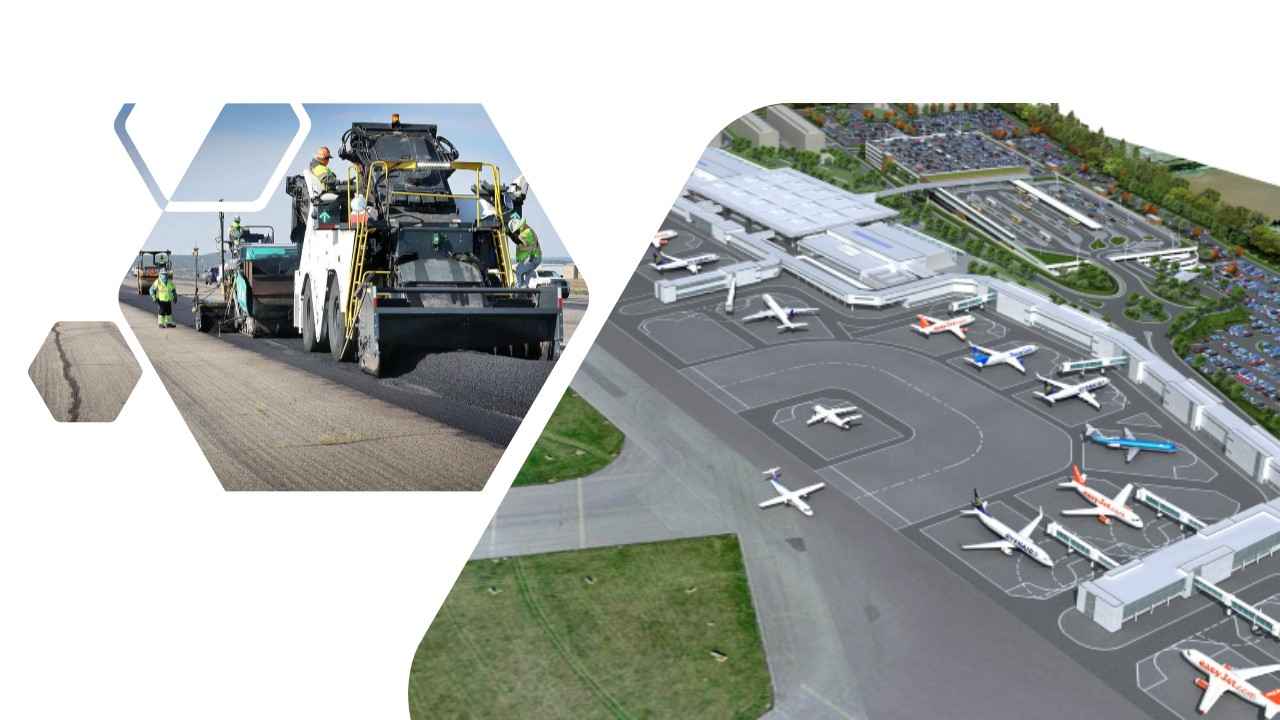Construction Machinery for Airport Construction Projects
- By
- Pooja |
- November 01, 2023 |
- Civil Engineering, Construction,

Table of Contents
Asphalt Pavers and Compactors:
Mobile Elevated Work Platforms (MEWPs):
Construction Surveying and Laser Systems:
Airport Operations and Safety:
Runway Alignment and Precision:
Airport construction projects are complex endeavors that demand a combination of precision, safety, and advanced engineering. These projects involve the creation and expansion of critical infrastructure to facilitate efficient air travel and cargo transportation.
Construction machinery plays a pivotal role in the successful execution of airport projects, enabling the development of runways, terminals, taxiways, and other essential facilities.
In this comprehensive post, we will explore the key types of construction machinery used in airport construction, their functions, benefits, and the challenges they help overcome.
Asphalt Pavers and Compactors:
Asphalt paving is crucial for constructing runways, taxiways, and aprons at airports. Asphalt pavers lay down a smooth and even layer of hot-mix asphalt, while compactors ensure proper compaction and density of the pavement. These machines contribute to the creation of durable and high-quality surfaces that can withstand heavy loads and frequent aircraft traffic.
Graders and Bulldozers:
Graders and bulldozers are essential for grading and leveling large areas of land, creating proper slopes and drainage for runways and taxiways. They are also used for earthmoving tasks, such as building embankments and constructing access roads.
Concrete Slipform Pavers:
Concrete slipform pavers are specialized machines used for constructing concrete pavements with precise dimensions. They are often employed in the construction of runways, taxiways, and terminal aprons. These pavers ensure consistent concrete placement, contributing to the longevity and structural integrity of airport pavements.
Read More:
Tower Cranes:
Tower cranes are indispensable in airport construction projects for lifting and placing heavy structural components such as terminal buildings, control towers, and hangars. Their impressive lifting capacities and precision make them crucial for assembling large and complex airport structures.
Material Handling Equipment:
Material handling equipment, including conveyor systems, forklifts, and cranes, plays a critical role in the movement of construction materials and components within the airport site. They enhance efficiency, reduce manual labor, and contribute to a smoother workflow.
Mobile Elevated Work Platforms (MEWPs):
MEWPs, also known as aerial lifts or cherry pickers, are used for tasks that require working at heights, such as installation, maintenance, and repairs on terminal buildings, lighting systems, and control towers. They provide a safe and stable platform for workers to access elevated areas.
Trenchers and Cable Plows:
Trenchers and cable plows are used for the installation of underground utilities and infrastructure, including electrical cables, communication lines, and water pipelines. Proper utility installation is crucial for the efficient operation of airport facilities.
Loaders and Haulers:
Loaders and haulers are employed for moving construction materials, debris, and excavated soil within the airport site. They contribute to maintaining a clean and organized construction environment and optimizing the use of available space.
Construction Surveying and Laser Systems:
Precise surveying and leveling are essential for accurate layout and alignment of runways, taxiways, and buildings. Robotic total stations, laser levels, and GPS equipment aid in achieving precise measurements and proper alignment.
Challenges and Solutions:
Airport Operations and Safety:
Airport construction projects often take place while the existing airport remains operational. Careful coordination and scheduling of construction activities, including equipment movement, material delivery, and noise control, are crucial to minimize disruptions to ongoing airport operations.
Stringent Quality Standards:
Airport pavements and structures must adhere to stringent quality standards and regulations to ensure safety and durability. Proper equipment maintenance, regular inspections, and adherence to construction specifications are essential to meet these standards.
Environmental Concerns:
Airports are subject to environmental regulations to minimize air and noise pollution. Construction machinery with low emissions, noise reduction features, and environmentally friendly practices help mitigate the environmental impact of airport construction.
Safety and Security:
Airport construction sites must prioritize safety and security, especially in sensitive areas such as air traffic control towers and security checkpoints. Strict adherence to safety protocols, worker training, and restricted access zones contribute to a safe construction environment.
Runway Alignment and Precision:
Runway alignment and precision are critical to ensure safe aircraft takeoffs and landings. Advanced surveying technology, such as GPS and laser systems, aids in achieving accurate runway alignment and ensuring compliance with aviation regulations.
Budget Management:
Airport construction projects involve significant financial investments. Effective budget management, equipment utilization, and efficient construction scheduling contribute to cost-effective project execution.
In conclusion, construction machinery is the backbone of airport construction projects, enabling the development of essential infrastructure that supports efficient air travel and cargo transportation.
From asphalt pavers and tower cranes to material handling equipment and surveying technology, each type of machinery contributes to the creation of safe, functional, and sustainable airport facilities.
By addressing challenges through innovation, adherence to regulations, and meticulous planning, airport construction projects continue to shape the global aviation landscape, connecting people and goods across the world with efficiency and reliability.
Please feel free to like, share and comment.
Admin, gcelab.com Please see our Pillar Post to know why we founded gcelab.com.
Read More:

Pooja
Founder at gcelab.com, Pooja is an Entrepreneur unlocking human potential. Working in the Principles of Lean Start-up, Pooja believes in Transparency and User Happiness the most. Pooja’s background in teaching gives her a sophisticated grasp on even the most tedious aspect of course building. She is passionate about people who believe that good is not enough.




